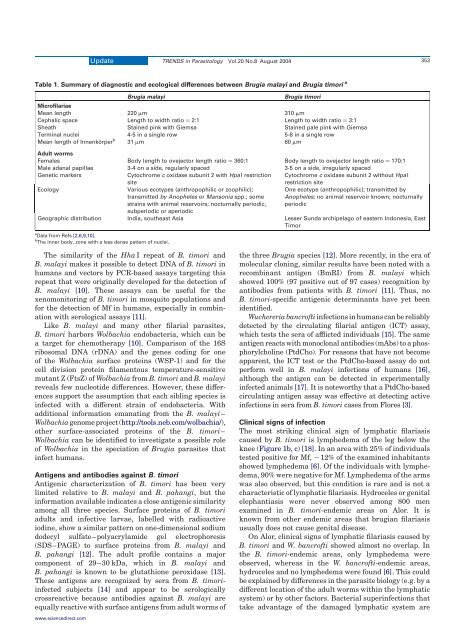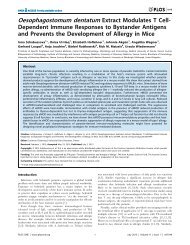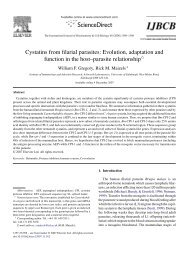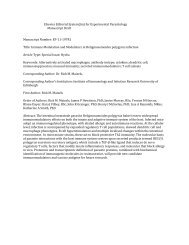Lymphatic filariasis and Brugia timori - Rick Maizels' Group ...
Lymphatic filariasis and Brugia timori - Rick Maizels' Group ...
Lymphatic filariasis and Brugia timori - Rick Maizels' Group ...
Create successful ePaper yourself
Turn your PDF publications into a flip-book with our unique Google optimized e-Paper software.
Table 1. Summary of diagnostic <strong>and</strong> ecological differences between <strong>Brugia</strong> malayi <strong>and</strong> <strong>Brugia</strong> <strong>timori</strong> a<br />
<strong>Brugia</strong> malayi <strong>Brugia</strong> <strong>timori</strong><br />
Microfilariae<br />
Mean length 220 mm 310 mm<br />
Cephalic space Length to width ratio ¼ 2:1 Length to width ratio ¼ 3:1<br />
Sheath Stained pink with Giemsa Stained pale pink with Giemsa<br />
Terminal nuclei 4-5 in a single row 5-8 in a single row<br />
Mean length of Innenkörper b<br />
31 mm 60 mm<br />
Adult worms<br />
Females Body length to ovejector length ratio ¼ 360:1 Body length to ovejector length ratio ¼ 170:1<br />
Male adanal papillae 3-4 on a side, regularly spaced 3-5 on a side, irregularly spaced<br />
Genetic markers Cytochrome c oxidase subunit 2 with Hpa I restriction Cytochrome c oxidase subunit 2 without Hpa I<br />
site<br />
restriction site<br />
Ecology Various ecotypes (anthropophilic or zoophilic);<br />
transmitted by Anopheles or Mansonia spp.; some<br />
strains with animal reservoirs; nocturnally periodic,<br />
subperiodic or aperiodic<br />
The similarity of the Hha I repeat of B. <strong>timori</strong> <strong>and</strong><br />
B. malayi makes it possible to detect DNA of B. <strong>timori</strong> in<br />
humans <strong>and</strong> vectors by PCR-based assays targeting this<br />
repeat that were originally developed for the detection of<br />
B. malayi [10]. These assays can be useful for the<br />
xenomonitoring of B. <strong>timori</strong> in mosquito populations <strong>and</strong><br />
for the detection of Mf in humans, expecially in combination<br />
with serological assays [11].<br />
Like B. malayi <strong>and</strong> many other filarial parasites,<br />
B. <strong>timori</strong> harbors Wolbachia endobacteria, which can be<br />
a target for chemotherapy [10]. Comparison of the 16S<br />
ribosomal DNA (rDNA) <strong>and</strong> the genes coding for one<br />
of the Wolbachia surface proteins (WSP-1) <strong>and</strong> for the<br />
cell division protein filamentous temperature-sensitive<br />
mutant Z (FtsZ) of Wolbachia from B. <strong>timori</strong> <strong>and</strong> B. malayi<br />
reveals few nucleotide differences. However, these differences<br />
support the assumption that each sibling species is<br />
infected with a different strain of endobacteria. With<br />
additional information emanating from the B. malayi–<br />
Wolbachia genome project (http://tools.neb.com/wolbachia/),<br />
other surface-associated proteins of the B. <strong>timori</strong>–<br />
Wolbachia can be identified to investigate a possible role<br />
of Wolbachia in the speciation of <strong>Brugia</strong> parasites that<br />
infect humans.<br />
Antigens <strong>and</strong> antibodies against B. <strong>timori</strong><br />
Antigenic characterization of B. <strong>timori</strong> has been very<br />
limited relative to B. malayi <strong>and</strong> B. pahangi, but the<br />
information available indicates a close antigenic similarity<br />
among all three species. Surface proteins of B. <strong>timori</strong><br />
adults <strong>and</strong> infective larvae, labelled with radioactive<br />
iodine, show a similar pattern on one-dimensional sodium<br />
dodecyl sulfate–polyacrylamide gel electrophoresis<br />
(SDS–PAGE) to surface proteins from B. malayi <strong>and</strong><br />
B. pahangi [12]. The adult profile contains a major<br />
component of 29–30 kDa, which in B. malayi <strong>and</strong><br />
B. pahangi is known to be glutathione peroxidase [13].<br />
These antigens are recognized by sera from B. <strong>timori</strong>infected<br />
subjects [14] <strong>and</strong> appear to be serologically<br />
crossreactive because antibodies against B. malayi are<br />
equally reactive with surface antigens from adult worms of<br />
One ecotype (anthropophilic); transmitted by<br />
Anopheles; no animal reservoir known; nocturnally<br />
periodic<br />
Geographic distribution India, southeast Asia Lesser Sunda archipelago of eastern Indonesia, East<br />
Timor<br />
a Data from Refs [2,6,9,10].<br />
b The inner body, zone with a less dense pattern of nuclei.<br />
www.sciencedirect.com<br />
Update TRENDS in Parasitology Vol.20 No.8 August 2004 353<br />
the three <strong>Brugia</strong> species [12]. More recently, in the era of<br />
molecular cloning, similar results have been noted with a<br />
recombinant antigen (BmRI) from B. malayi which<br />
showed 100% (97 positive out of 97 cases) recognition by<br />
antibodies from patients with B. <strong>timori</strong> [11]. Thus, no<br />
B. <strong>timori</strong>-specific antigenic determinants have yet been<br />
identified.<br />
Wuchereria bancrofti infections in humans can be reliably<br />
detected by the circulating filarial antigen (ICT) assay,<br />
which tests the sera of afflicted individuals [15]. Thesame<br />
antigen reacts with monoclonal antibodies (mAbs) to a phosphorylcholine<br />
(PtdCho). For reasons that have not become<br />
apparent, the ICT test or the PtdCho-based assay do not<br />
perform well in B. malayi infections of humans [16],<br />
although the antigen can be detected in experimentally<br />
infected animals [17]. It is noteworthy that a PtdCho-based<br />
circulating antigen assay was effective at detecting active<br />
infections in sera from B. <strong>timori</strong> cases from Flores [3].<br />
Clinical signs of infection<br />
The most striking clinical sign of lymphatic <strong>filariasis</strong><br />
caused by B. <strong>timori</strong> is lymphedema of the leg below the<br />
knee (Figure 1b, c) [18]. In an area with 25% of individuals<br />
tested positive for Mf, ,12% of the examined inhabitants<br />
showed lymphedema [6]. Of the individuals with lymphedema,<br />
90% were negative for Mf. Lymphedema of the arms<br />
was also observed, but this condition is rare <strong>and</strong> is not a<br />
characteristic of lymphatic <strong>filariasis</strong>. Hydroceles or genital<br />
elephantiasis were never observed among 800 men<br />
examined in B. <strong>timori</strong>-endemic areas on Alor. It is<br />
known from other endemic areas that brugian <strong>filariasis</strong><br />
usually does not cause genital disease.<br />
On Alor, clinical signs of lymphatic <strong>filariasis</strong> caused by<br />
B. <strong>timori</strong> <strong>and</strong> W. bancrofti showed almost no overlap. In<br />
the B. <strong>timori</strong>-endemic areas, only lymphedema were<br />
observed, whereas in the W. bancrofti-endemic areas,<br />
hydroceles <strong>and</strong> no lymphedema were found [6]. This could<br />
be explained by differences in the parasite biology (e.g. by a<br />
different location of the adult worms within the lymphatic<br />
system) or by other factors. Bacterial superinfections that<br />
take advantage of the damaged lymphatic system are





